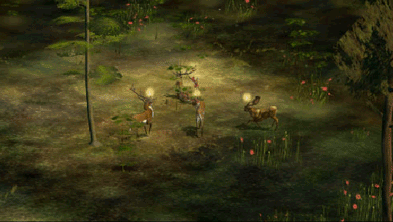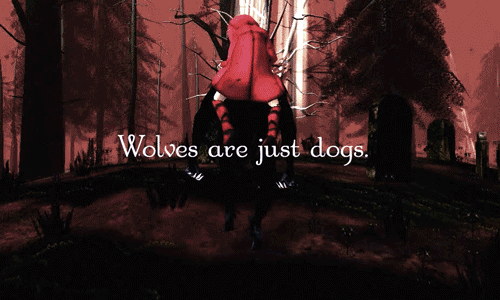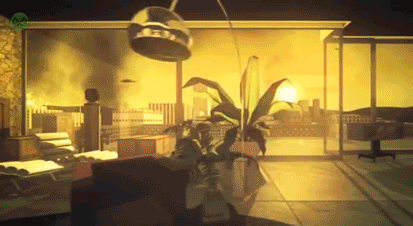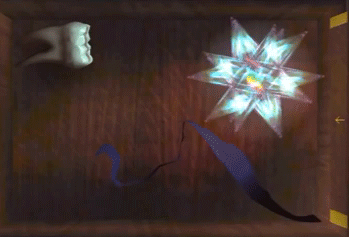As Video Game Developers Tale of Tales Change Direction, A Look Back on Their Career So Far

In June of 2015, video game studio Tale of Tales announced they would stop making video games after lackluster sales of their most recent game, Sunset. The news has widely been distributed throughout the gaming world with sadness—Tale of Tales create moving, poetic video games that are art works in and of themselves. Their Creative Capital Project, The Path, for instance, was praised as taking the concept of video games to a new level.
We checked in with Tale of Tales to revisit their career so far and to find out whether there was not a positive spin to their announcement after all.
Alex Teplitzky: I read that you met on the internet in 1999. Meeting people online is more common now, but less so then. What platform did you meet on, and when how did you meet IRL?
Michaël Samyn: We were both members of an online artists collective around the hell.com domain. A bunch of us had gathered in a videochat application (quite rare in those days) to see how it could be used for artistic purposes. Auriea was broadcasting blurry black and white webcam images of herself and I was posting pictures of fruits and vegetables (I didn’t have a camera connected to my computer and my modem connection wouldn’t have been up to a stream either). The application had a mode to speak privately and when Auriea and I started talking it was like a stream of poetry, a very rich and sensual exchange. It was only after we stopped that we realized we probably had a sex chat.

The next day I posted a web page on the members-only part of hell.com that included a link to a page that didn’t exist. Auriea responded by creating that page, with a new link. And so on. This romantic exchange of images and text became our first collaborative project called Skinonskinonskin.
We decided to work together and to pretend we were not falling in love. We were both in serious relationships and I had two toddler children. There was no way we would leave our partners.
Through a coincidence, a few months later we both needed to be in San Francisco around the same time (Auriea lived in New York back then, and I in Belgium). So I told her not to bother with getting a hotel room.
After that our fate was sealed. We made several attempts to break up and save our existing relationships. But to no avail. This was destined to be, no matter how much pain our joining would cause to others. Some months later, Auriea moved to Belgium.
All of this happened in a few months time. I still feel kind of embarrassed about the rashness of it. But the proof is in the pudding. We’re still together and love each other dearly. My kids are going to university now. I think they’re okay.
Alex: I’m often reminded of games like Ico and Flower when reading about your work. What games were influential to you before you became video game designers?
Auriea: We’ve been doing this for a while. We had already developed our first game concept and the core of our design philosophy before Ico was released. When we found out about it, we eagerly anticipated the release. And bought it on launch day. If only because of the similarities to our own project 8: the game was also about a child in a big castle and featured a semi-autonomous character. And we had quickly bonded with Thatgamecompany quite early on too. We even called each other sister companies. So Flower, like Ico, functioned more as a confirmation of our ideas and a feeling of camaraderie than actual influence.
We are influenced by many things. And by many games too. By many bad ones even. Or by elements in games that are not part of the core design, or even the intended effect, or mistakes sometimes. Myst, Doom, Tomb Raider and Tekken were all early influences, even on our work before games. Later Silent Hill, Project Zero, Black & White, Animal Crossing, Neverwinter Nights and even Guild Wars had their influence on our work. Also important were early CD-Roms like Ceremony of Innocence by Alex Mayhew.

“The Endless Forest” consists of “an idyllic forest on the internet, [where] magical deer play joyfully with many online friends in perfect harmony…. Discover ancient artifacts and have a chance to meet the forest gods and experience their limitless power.”
Michaël: That actually already started before The Endless Forest. Our ideas for our very first never finished game 8 resonated with a lot of people. Demos of the game have even been exhibited in several festivals. We knew early on that there was an interest in our approach.
But it wasn’t until we actually saw people play our work that we felt confident. We had released a first phase of The Endless Forest, much smaller and more limited than the current game. All avatars looked alike and there were only 4 or 5 actions. There were no missions or quests or any defined activities. But players ran with it. They invented ways of amusing themselves with the little elements we gave them. This has remained at the heart of how we design for interactive media: we only design half of the game, website, etc, and the player/spectator makes up the other half.
We were completely baffled to see later on how many players were creating a seemingly never-ending stream of drawings inspired by our game. We actually implemented several of their ideas in the game. And we set up a website where they can share their drawings and stories. Sometimes it feels like that website is even more active than the game.

Tale of Tales’ Creative Capital project, “The Path,” is a poetic take on the Little Red Riding Hood fable. “Playing ‘The Path’ is as rewarding as reading a literary novel,” said one reviewer.
Alex: Often in works, like your Creative Capital project The Path, the user is specifically encouraged to disobey the rules of the game, and in many of the games, you violate specific video game commonalities or tropes. Can you talk more about your goals and reasoning behind this?
Auriea: Messing with players’ expectations is really only a secondary concern. Our main design is motivated by expressing our story, our atmosphere, our characters. Since we often choose subject matter that is unusual in games, it follows logically that the systems and rules in our games will be different too. If there is an opportunity to bend a game convention to express something we want, we sometimes use it.
The interface in The Path to make a character do something is not pressing a button but releasing all buttons, basically letting go of the controls. That hooks into our story about lack of control and the sensation of concern for a young person that we wanted to evoke.
Or in Luxuria Superbia we used a score number to express to the player how much the game is enjoying their touches. A translation into numbers of a person saying “Yes, baby, there, touch me there, don’t stop.”
Or even in our latest game Sunset, since our protagonist is a housekeeper, we use a list of chores to tell players what to do. But the game doesn’t exactly reward you for doing those tasks. It responds to all behavior (or lack of behavior) to change the story slightly. Not doing the tasks also has an effect. There is no correct way to play it.
It’s fun for us to hook into these conventions and sometimes it also helps gamers to understand and enjoy the game. Many don’t mind subversion of conventions. But many have difficulty handling completely unconventional designs.

In Tale of Tales’ most recent game, Sunset, you play as a housekeeper in a fictional Latin American country. As you complete chores, you are complicated into a rebellious plot against a notorious dictator, Generalísimo Ricardo Miraflores.
Alex: From The Graveyard to Sunset your work has completely challenged video games as strictly a form of entertainment and moved it more into art works. With the announcement that you won’t be developing video games, how do you expect your studio practice will evolve? And, specifically, what do you hope the developing place of video games will be in the art world? MoMA and other museums have been acquiring video games as art works, but I still think institutions have a lot to work on to present these works to an audience that is clearly hungry for them. I wonder, for instance, why you can’t go to the MoMA website to play the video games in their collection. What are your thoughts on this?
Michaël: It was my understanding that MoMA has acquired the games as design objects, not art. But in general I don’t think museums are necessarily good places to demonstrate games. They are a different kind of art form. We don’t see novels in art museums, or theater or opera, or film. There’s many art forms that are experienced outside of the museum. Games are not unique in that respect.
This of course leaves videogames in something of a vacuum when it comes to artistic recognition. For years now, many game journalists have been transforming themselves into art critics in response to the increasing attempts at artistic creation in the medium. But their approach often remains DIY and instinctive. It is rare to find someone who can situate a game in a larger cultural context without either platitudes along the line of “since Duchamp’s Fountain everything can be art” or semi-mystical statements about how sports go beyond art as a new form of poetry.
And it doesn’t help that games are such a successful and competitive industry. The commercial motivation to create is very strong. And since non-commercial funding is largely lacking, this even applies to the very small artistically inspired studios. As a result creative evolution in games is glacial, because we always need to cater to the existing audience’s desires (which becomes a self-fulfilling spiral). I don’t think any videogames have been made yet that can be considered masterworks of art, next to works of that quality in other media. And I’m not certain this will ever happen. Not for lack of potential but because there is insufficient support for the work required to achieve that level.
With our last game, Sunset, we made a deliberate effort to tap into any commercial appeal we thought our style and talents and skills could produce. But it failed to be as commercially successful as expected. Since we feel confident that we tried our best, we also feel that this is an experiment we do not need to repeat. So as of now, everything we create must happen outside of concerns about sales. We might still create game-like programs. But we are also curious about other media.

Alex: Despite video game publications spreading the news of your retirement (sort of) from video game-making as really bad news, I read your announcement as a breath of relief. There’s a positive spin to it, in a way, that the traditional model of video game sales is not something that works for you. Am I correct in reading it this way?
Auriea: Yes, actually. We’ve always had a problematic relationship with the larger games industry. It could be said that our mission with Tale of Tales was always primarily cultural. We were working to create dialogs around the medium of videogames: what videogames are and could be, and how the various technologies and concepts used to create them could be thought of beyond conventional game concepts.
Over the years we’ve perhaps given in too much to reliance on the more commercial aspects of the games industry system. This was a mistake because we are not good at selling. So, the solution is to not put ourselves in the position of having to sell anything. We do not want our work to be merely games based on the wrote requirements of selling what we make to gamers. And we feel there are other creative projects to which we would like to apply the Tale of Tales design philosophy.
We see this moment as a chance to correct our trajectory and put us back on the correct path. An opportunity to branch out into other fields.
To be honest, we’ve had a problematic relationship with games ever since the release of The Path in 2009. We started using computers for our art to be able to connect to our audience directly. First on the web, then through games. But we hadn’t anticipated that instead of ignoring things they didn’t like, many gamers felt the need to express how they hated our work, and they often do so in disturbingly uncouth ways. As a result, creating games that deviate from thematic and formal conventions requires walking on eggshells and is ultimately very discouraging for creativity.
Our last game, Sunset, was our final attempt to reach gamers in a way that we hoped they could deal with. But while the game was at least as successful as our other releases, it did not manage to expand our audience beyond that. And in a way, yes, that’s a relief. Now we no longer need to cater to these people. They clearly don’t want us. So it’s a happy divorce.
We are looking forward to working in media where we feel encouraged to explore, to experiment, to do things that have never done before. Instead of being constantly told we’re taking things too far, our work is too difficult, too brainy, boring, that it should be more like conventional fare, etc. Tale of Tales is considered avant-garde in game circles. That is ironic because we consider ourselves as classicists with a well developed skepticism for modernism and contemporary art. We find our “deviations” simply a natural element of creativity. Why would one make something that already exist?
There’s also a technical element. We just don’t have access to the kinds of budgets that would be required to make the kind of work we really want to make at the quality we want to see it. So far we’ve been satisfied with what we were able to achieve and enjoyed the technical shortcomings of our work as a natural part of interactive work (i.e. the spectator needs to do part of the work). But the tolerance for this seems to be declining rapidly in the game audience to the point where some will refuse to play a game because it doesn’t run at 60 frames per second on their mediocre computer. Not only do we not have access to the money required to achieve this, we’re also completely uninterested in that sort of technological machismo.
At the beginning of our career in media art, we made the conscious decision to not learn how to program in C++. Because we felt that if we would become engineers it would be at the expense of being artists. We’d rather create crappy software that is beautiful and moving than perfectly functional applications that are dull and empty. And we have found an audience for this. We’re very happy with that. But since it’s just not large enough to sustain us in the commercial market, we will find other ways to create art for them.
Find out more about Tale of Tales and purchase their video games on their website.

